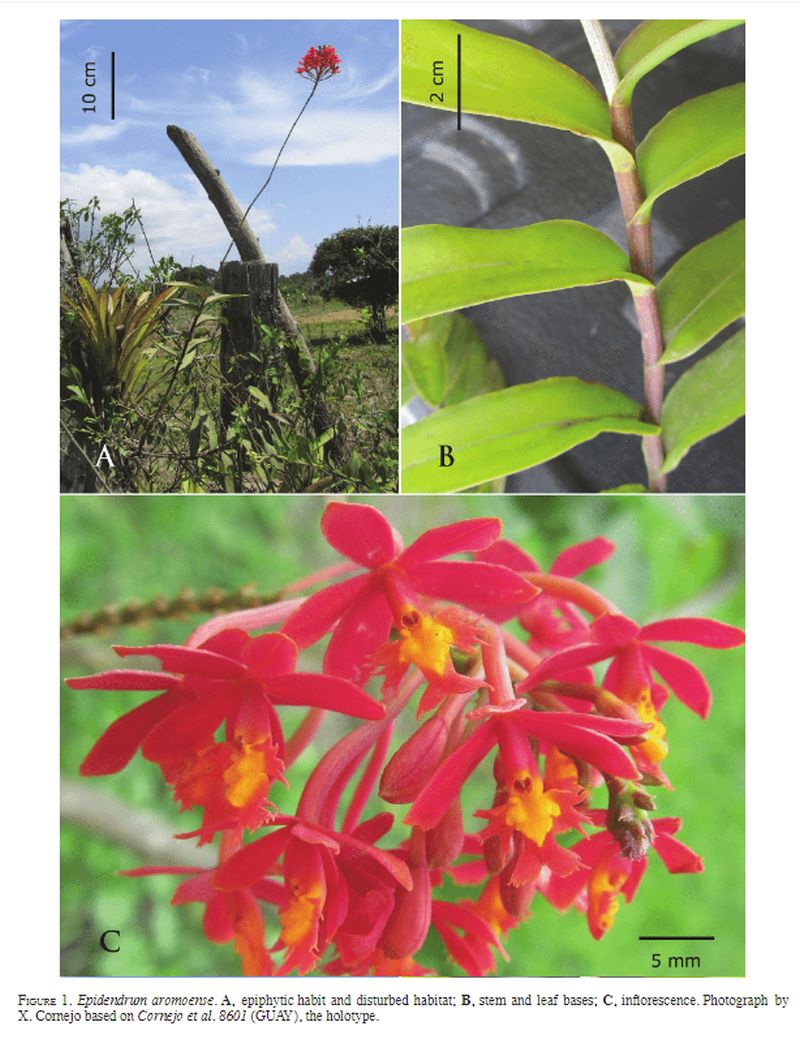

Epidendrum aromoense Cornejo & Hágsater 2014 GROUP Secundum SUBGROUP Elongatum
Photo by © Xavier Cornejo and The Research Gate Website
TYPE Drawing by © Jimenez, Hágsater & E.Santiago and The AMO Herbario Website



Common Name The El Aromo Epidendrum [A locality in western Ecuador]
Flower Size .6" [1.5 cm]
Found in western Ecuador on the western slopes of the Andes in seasonally foggy, very dry coastal forests at elevations around 200 meters as a medium sized, hot growing epiphyte with cane-like, simple, terete, thin stems carrying 7 to 12, all along the stem, coriaceous, alternate, sub-erect, lower leaves lanceolate-oblong, upper ones oblong, broadly obtuse on the upper leaves, slightly bilobed, margin entire leaves that blooms in the summer on a terminal, racemose, peduncle 11" [28.5 cm] long, elongate, terete, thin, straight, nearly totally enveloped by 8 acute, tubular sheaths, rachis 3" [7.5 cm] long, terete, thin, successively 18, 30 to 40 flowered inflorescence with much shorter than the ovary, triangular-lanceolate, acuminate, gradually shorter above floral bracts and carrying non-resupinate, lacquer red flowers with an orange callus [appears yellow in photos].
"Epidendrum aromoense belongs to the GROUP Secundum SUBGROUP Elongatum which is recognized by the caespitose habit, simple stems, leaves oblong-lanceolate, coriaceous, bilobed and elongate peduncle of the erect, pluriracemose inflorescence, the flowers non-resupinate, the callus complicated, plurituberculate. The species is recognized by the successive, lacquer-red flowers, the orange callus, sepals about .36" [9 mm] long, the petals somewhat smaller than the sepals, oblanceolate, the lip square in outline, deeply 3-lobed, the lateral lobes dolabriform, terminating in a pair of divaricate, narrow, triangular, acute, bifurcate teeth, the lateral lobes clearly separate and never overlapping with the mid-lobe when spread, and the mid-lobe rather acutely dentate to somewhat flabellate, bilobed and distinctively divaricate; callus concave within, 5-tuberculate, 2 globose processes, 2 outer, smaller flat growths, and an apical-V shaped protuberance like the bow of a ship, the apex acute. The distinctive pattern of distribution, that is, restricted to the lowlands of central-western Ecuador (versus Andean) makes an easy differentiation for E. aromoense in comparison to the remaining red-flowered species in the subgroup.
"Similar red-flowered species are: Epidendrum tulcanense Hágsater & Dodson has also red flowers but it is distinguished by the large white massive callus, formed by nine unequal tubercles: four basal ones and the main structure formed by five sub-equal tubercles. Epidendrum laurelense Hágsater & Dodson, that differ from E. aromoense by the carmine-red flowers on a much more open raceme, with a massive white callus formed by a semicircular sulcate, marginally plurilobulate fleshy plate, found between Tulcán and Maldonado, on the border between Ecuador and Colombia, on roadsides and rocks in wet forest between at around 2000 to 2500 meters above sea level. Epidendrum coroicoënse Schltr. is another species similar to E. aromoense by the lacquer-red flowers; however, the former species is known from southern Peru and western Bolivia, along the upper Amazon slope of the Cordillera Oriental of the Andes, and differ from E. aromoense by the narrow leaves about 6 to 7 times longer than wide, the petals wider than the sepals, elliptic-sub-orbicular, the lip bearing lateral lobes overlapping with the mid-lobe when spread; and callus 5-tuberculate with two basal and three apical tubercles, and without keels. Epidendrum portokalium Hágsater & Dodson is another species with red flowers that resembles E. aromoense, but it is found on the Amazon slopes of the Andes in central Ecuador, and differs from E. aromoense by the callus unequally 7-tuberculed (with four basal tubercles and three apical ones" Epidendrum aromoense (Orchidaceae, Laeliinae), a New Species from the Coastal Dry Forests in Western Ecuador, The Research Gate Website
Synonyms
References W3 Tropicos, Kew Monocot list , IPNI ; *Harvard Papers in Botany, Vol. 19, No. 2, 2014, pp. 185–188. Cornejo & Hagsater 2016 photo/drawing fide; Icones Orchidacearum 16(1): t. 1605 Hagsater etal 2018 drawing/photo fide; Icones Orchidacearum 16[1] Plate 1659 Hagsater & Sanchez 2018 See recognition section;
----------------------------------------------------------------------